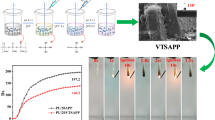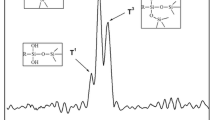Abstract
Ammonium polyphosphate surface-modified by silane coupling agent (3-aminopropyl) triethoxysilane (KH-550), named STAPP, incorporated with pentaerythritol and melamine to prepare intumescent flame retardant unsaturated polyester resin (UPR/IFRs). Surface groups, surface elements, thermal stability and surface morphology of STAPP were characterized by Fourier transform infrared spectroscopy, X-ray photoelectron spectroscopy, thermogravimetric analysis (TG) and scanning electron microscopy (SEM). The flame retardancy of the UPR composites was studied by limit oxygen index (LOI), vertical burning test (UL-94) and cone calorimeter test, and its thermal stability was evaluated by TG. The results showed that IFRs greatly improves flame retardancy, thermal stability and carbon formation ability of UPR. Compared with pure UPR, when the loading of IFRs was 25 mass%, the LOI was increased from 19.8 to 41.5%, the UL-94 test reached the V-0 rating from NR, peak heat release rate and total smoke production was decreased by 54.1 and 38.7%. Furthermore, the addition of IFRs delayed the product of smoke and release heat. TG results showed that 27.6 mass% chars remained in UPR/IFRs at 1073 K, showing a good char forming ability. Besides, honeycomb-type carbon layer with few cracks and holes was observed by SEM. Finally, the flame retardancy mechanism of IFRs was elaborated in detail, which was attributed to the siloxy groups and expanded carbon layer.













Similar content being viewed by others
References
Chen Z, Yu Y, Zhang Q, et al. Preparation of phosphorylated chitosan-coated carbon microspheres as flame retardant and its application in unsaturated polyester resin. Polym Adv Technol. 2019;30(8):1933–42.
Reuter J, Greiner L, Kukla P, et al. Efficient flame retardant interplay of unsaturated polyester resin formulations based on ammonium polyphosphate. Polym Degrad Stab. 2020;178:109134.
Gao M, Wang Y, Chen X, et al. A mussel-inspired intumescent flame-retardant unsaturated polyester resin system. J Therm Anal Calorim. 2019;138:1097–106.
Shaw S. Halogenated flame retardants: do the fire safety benefits justify the risks? J Rev Environ Health. 2010;25(4):261–306.
Zhang K, Wu H, Wang T, et al. Flame-retardant effect of cross-linked phosphazene derivatives and pentaerythritol derivatives on polypropylene. J Therm Anal Calorim. 2020. https://doi.org/10.1007/s10973-020-09898-z
Le Bras M, Bourbigot S, Delporte C, et al. New intumescent formulations of fire-retardant polypropylene-discussion of the free radical mechanism of the formation of carbonaceous protective material during the thermo-oxidative treatment of the additives. J Fire Mater. 1996;20(4):191–203.
Bourbigot S, Bras ML, Delobel R, et al. 4A zeolite synergistic agent in new flame retardant intumescent formulations of polyethylenic polymers—study of the effect of the constituent monomers. Polym Degrad Stab. 1996;54(2–3):275–87.
Bras ML, Bugajny M, Lefebvre JM, et al. Use of polyurethanes as char-forming agents in polypropylene intumescent formulations. J Polym Int. 2000;49(10):1115–24.
Lin H, Yan H, Liu B, et al. The influence of KH-550 on properties of ammonium polyphosphate and polypropylene flame retardant composites. Polym Degrad Stab. 2011;96(7):1382–8.
Qin Z, Li D, Zhang W, et al. Surface modification of ammonium polyphosphate with vinyltrimethoxysilane: preparation, characterization, and its flame retardant in polypropylene. Polym Degrad Stab. 2015;119:139–50.
Sha L, Chen K. Surface modification of ammonium polyphosphate-diatomaceous earth composite filler and its application in flame-retardant paper. J Therm Anal Calorim. 2016;123:339–47.
Shen MY, Chen WJ, Kuan CF, et al. Preparation, characterization of microencapsulated ammonium polyphosphate and its flame retardant in polyurethane composites. J Mater Chem Phys. 2016;173:205–12.
Tang Q, Wang B, Shi Y, et al. Microencapsulated ammonium polyphosphate with glycidyl methacrylate shell: application to flame retardant epoxy resin. J Ind Eng Chem Res. 2013;52(16):5640–7.
Yang L, Cheng W, Zhou J, et al. Effects of microencapsulated APP-II on the microstructure and flame retardant of PP/APP–II/PER composites. Polym Degrad Stab. 2014;105(1):150–9.
Jiang M, Zhang Y, Yu Y, et al. Flame retardancy of unsaturated polyester composites with modified ammonium polyphosphate, montmorillonite, and zinc borate. J Appl Polym Sci. 2018;136:47180.
Wu K, Wang Z, Hu Y. Microencapsulated ammonium polyphosphate with urea–melamine–formaldehyde shell: preparation, characterization, and its flame retardance in polypropylene. Polym Adv Technol. 2008;19(8):1118–25.
Wang X, Li Y, Liao W, et al. A new intumescent flame-retardant: preparation, surface modification, and its application in polypropylene. Polym Adv Technol. 2008;19(8):1055–61.
Qu H, Wu W, Hao J, et al. Inorganic–organic hybrid coating-encapsulated ammonium polyphosphate and its flame retardant and water resistance in epoxy resin. J Fire Mater. 2014;38(3):312–22.
Arkles B. Silane coupling agents: connecting across boundaries. Morrisville Gelest. 2003;2003:9–12.
Anna P, Marosi G, Bourbigot S, et al. Intumescent flame retardant systems of modified rheology. Polym Degrad Stab. 2002;77(2):243–7.
Wu K, Wang Z, Liang H. Microencapsulation of ammonium polyphosphate: preparation, characterization, and its flame retardance in polypropylene. J Polym Compos. 2008;29(8):854–60.
Nie S, Song L, Guo Y, et al. Intumescent flame retardation of starch containing polypropylene semibiocomposites: flame retardancy and thermal degradation. J Ind Eng Chem Res. 2009;48(24):10751–8.
Bugajny M, Bourbigot S, Le Bras M, et al. The origin and nature of flame retardance in ethylene-vinyl acetate copolymers containing hostaflam AP 750. J Polym Int. 1999;48(4):264–70.
Li B, Sun CY, Zhang XC. An investigation of flammability of intumescent flame retardant polyethylene containing starch by using cone calorimeter. Chem J Chin Univ. 1999;20(1):146–9.
Qin H, Su Q, Zhang S, et al. Thermal stability and flammability of polyamide 66/montmorillonite nanocomposites. J Polym. 2003;44(24):7533–8.
Guo B, Zhang T, Zhang W, et al. Influence of surface flame-retardant layer containing ammonium polyphosphate and expandable graphite on the performance of jute/polypropylene composites. J Therm Anal Calorim. 2019;135:2367–75.
Camino G, Costa L, Trossarelli L. Study of the mechanism of intumescence in fire retardant polymers: part II-mechanism of action in polypropylene-ammonium polyphosphate-pentaerythritol mixtures. Polym Degrad Stab. 1984;7(1):25–31.
Acknowledgements
This research was supported by the National Key Research and Development Plan (Grant No. 2016YFC0800100); the Natural Science Foundation of the Jiangsu Higher Education Institutions of China (Grant No. 18KJB620002); Jiangsu Provincial Basic Research Program (Natural Science Foundation)—Youth Foundation Project (No. BK20190690) and the China Postdoctoral Science Foundation (No. BK20190690).
Author information
Authors and Affiliations
Corresponding author
Additional information
Publisher's Note
Springer Nature remains neutral with regard to jurisdictional claims in published maps and institutional affiliations.
Rights and permissions
About this article
Cite this article
Chen, Z., Yu, Y., Zhang, Q. et al. Surface-modified ammonium polyphosphate with (3-aminopropyl) triethoxysilane, pentaerythritol and melamine dramatically improve flame retardancy and thermal stability of unsaturated polyester resin. J Therm Anal Calorim 143, 3479–3488 (2021). https://doi.org/10.1007/s10973-020-10282-0
Received:
Accepted:
Published:
Issue Date:
DOI: https://doi.org/10.1007/s10973-020-10282-0




